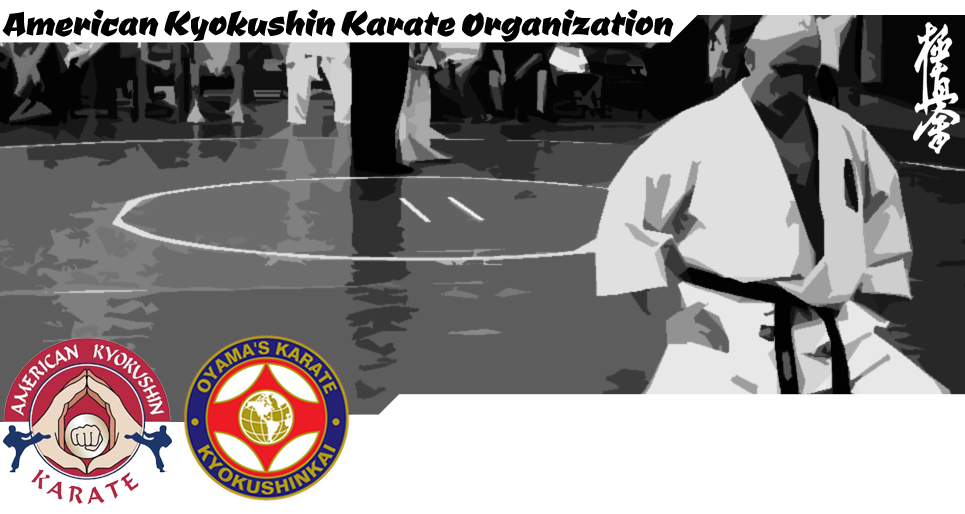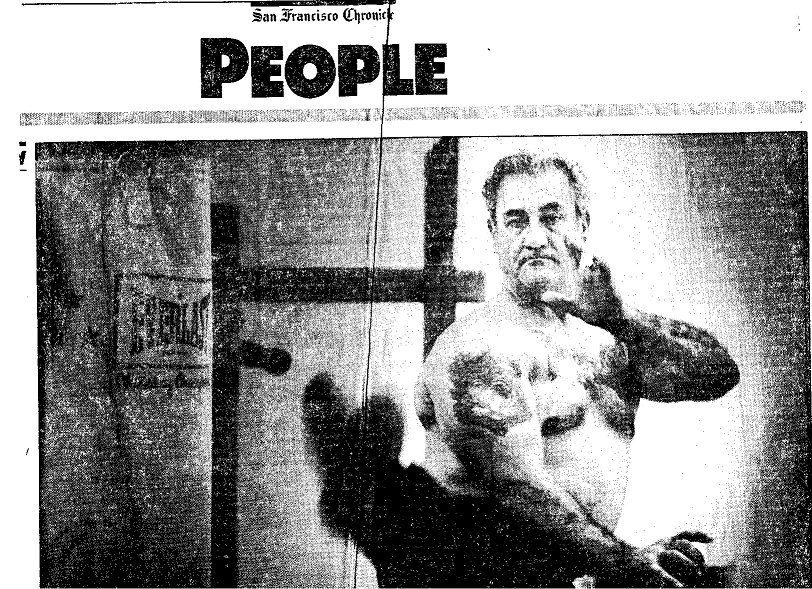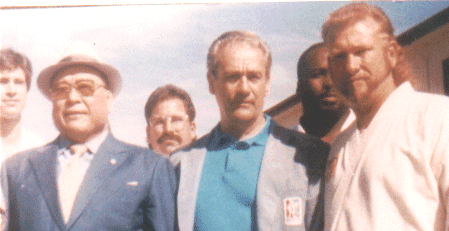Black Belt Magazine article on Hanshi Don Buck and Kyokushin

AKKO sends team too Salt Lake City Utah for Full contact International Tournament. They were under dogs to win. But they did great!

Recently, the Martial Arts World has lost quite a few great men. Masters of all walks of life seem to be falling ill or finding their final peace. The next few pages have been dedicated to these men. May God Bless their families and friends and guide them to find the strengths they need to go forward in their lives.
On September 11, 1998 at 3:08 am, the Martial Art World suffered a great loss. Donald Irving Buck 10th Dan MDTC, passed away in his sleep at the age of 72.
Donald Buck began studying the marial arts over 50 years ago in San Fransisco. He was one of the few people who received a Black Belt of teacher credentials in Judo, Karate, Kung Fu and Jujitsu. He has gone to join his Sensei, Mas Oyama in the Great Martial Art world in the sky.
Donald Buck passed away in his sleep Friday, at his home in Benecia. He was a well known and respected martial artist and teacher. A retired SF Police Officer, Sensei Donald Buck has touched many lives. From the students who studied at the local naval bases to the students who were with him in the end. He started teaching martial arts in the 40′s and taught at many Northern California Naval Bases and privately as well. He was the Chairman for the Kyokushin Karate organization and he received his 7th Dan from Mas Oyama before his death in 1989. Donald Buck received his 10th Dan in the American Kyokushin Karate Orgainization and has a doctorate in Traditional Chinese Medicine. He will also be remembered for his great sense of humor and superior strength. Donald was a veteran of World War II and trained special forces in the Admirality Islands.
He is survived by his wife, Mariette, three children, Fred, Donald, and Teri, sister and brother-in-law Patricia and Julian Landman, brother Edward, several nieces and nephews, six grandchildren and close family friends and many loyal and devoted martial arts students all over the world. Family memorial services were private. Donations preferred to the amateur Athletic Uniion, 2874 Norcross Drive, Sacremento, CA 95833. The American Kyokushin Organization will continue under the direction of his son Fred, wife Mariette and the AKKO council.
Don Buck was both kind and powerful. He spent his entire life helping others and teaching the martial arts. HIs close friend and teacher, Mas Oyama gave Don Buck the title of “Fierce Tiger.”
In his youth, Don Buck grew up on the tough streets of San Francisco. He was very athletic and spent hours practicing gymnastics in Golden Gate Park.
During WWII, he served in the Admirality Islands where he taught hand to hand combat. While in the miltary, he became a boxing champion. While not on duty, he practiced other martial arts including knife fighting.
After the war, in 1945, he returned to the San Francisco bay area where he resumed weight lifting and began to train under Duke Moore in Judo and Jujitsu.
In 1955, Don Buck was contacted by karate legend Mas Oyama. Sensei Buck began a lifelong friendship with the founder of Kyokushin karate. According to Don Buck, “we trained together for hours.” This workout included karate as well as boxing, judo, jujitsu techniques. Both men were extremely aggresisive and strong. They were also highly trained in the mental and physical aspects of the martial arts. On trips to America, Mas Oyama would make a point of staying with his friend Don Buck.
Don Buck made several trips to China and Japan to increase the depth of his knowledge and to share his expertise others. He was awarded the honorary degree of M.D.T.C.M. (doctor of traditional Chinese medicine) by the Hong Kong Naturopathy Association. He also trained with other high-ranking martial artists who had immigrated to the San Fransisco Bay area.
Don Buck was instrumental in founding the AAU for Karate and KungFu. He was the founder of his own school known as “School of the Tiger.” He trained many outstanding karate Sensei, including his wife, Mariette Buck, Alice Euguchi, his 2 sons, Fred and Don Jr., Steve Senne, Larry Giordano, Birney Jarvis, John Pell and Mike Dayton (former Mr. America). In 1989, he encouraged his student, friend and personal physician, Dr. Daniel Andrews , to start teaching karate to the public (prior to this, Dr. Andrews only taught family members). Buck believed that “all of the arts are one.”
Sosai Mas Oyama Our founder and Mentor
By Calos Valez III
Masutatsu ‘Mas’ Oyama, 10th dan, founder of Kyokushin Karate, was born in 1923 in southwestern Korea. He started training in Chinese Kempo at the age of nine. When he was fifteen years old his father sent him to Japan to study at the Yamanashi Youth Aviation Institute. He trained in Judo for a short while, before starting Karate under Gichin Funakoshi’s tuition.
The life of Mas Oyama, Japan’s modern day Miyamoto Musashi, was nothing short of incredible. As the first man to take the Art of Karate to the West, Oyama’s great desire was to show the world that not only was Karate the most powerful and devastating fighting Art in existence, it was a way of life with roots in the most profound philosophies of the East. Mas Oyama passed away in April of 1994.
They Jump, They Kick, They Scream.. They Teach Philosophy
By Jerry Carroll
The hottest movie this summer continues the story about
the wise counsel a martial arts master gives his young
student. “Karate Kid, Part II” grossed $61.6 million in five
weeks, Which is better than a blow to the windpipe.
In the movie, kindly and unflappable Mr. Miyagi
takes gangly Danny LaRusso back home to
Okinawa-home of karate- for mare instruction
in kicks, chops, punches and Eastern serenity.
The pair tangles with another karate master
and his pupils, saves a village from destruction,
survives a typhoon and
generally upholds goodness and beats up on evil.
There’s some romantic stuff, but it doesn’t take
up so much time that it ruins the movie for he
teenage boys payinghard cash to see lights punched
out. So “Karate Kid, Part II” thus maintains the
martial arts boom begun by the movie exploits of
the late Bruce Lee and continued by Chuck Norris.
Television is tiding the wave as well. In the fall, ABC
will offer a new series, “The Last Electric Night,”
about a cop and his karate champ pal. NBC’s
defunct series about an American ninja, “The Master,”
is being repackaged for the video stores. Plus,
you’re seeing more full-contact karate matches on
ESPN, the cable network.
“Karate has a mystical quality to it,” said Michael
Weisbarth, executive producer of “Electric Night.”
“It is an area where people can see action that is
based on honor and defense.”
‘The Terrible Tiger’
Nobody’s happier about all this than your real-life
martial arts master. Being seen as a sage able to
catch flies with chopsticks while entertaining
questions about the meaning of life isn’t
exactly a bad image. “I think the old man is great,”
said Don Buck, 60, of the School of the Tiger of
Bencia. “Things come from his heart.”Buck, who is
built along the lines of a fireplug, may be the most legendary
of the masters in the Bay Area. He holds the title of sensei
in karate and sifu in kung fu.
Although somewhat mellowed now, he was
known as the “Terrible Tiger” by his rivals.
Buck once took on an entire karate school,
defeating the students one by one in several
matches, leaving several with injuries. He
knocked the star student senseless for 17
minutes with a two-knuckle punch and then
licked the school’s master.
Although somewhat mellowed now, he was
known as the “Terrible Tiger” by his rivals.
Buck once took on an entire karate school,
defeating the students one by one in several
matches, leaving several with injuries. He
knocked the star student senseless for 17
minutes with a two-knuckle punch and then
licked the school’s master.
Buck began teaching hand-to-hand combat
in World War II and now holds a ninth-degree
black belt, one short of the ultimate. He
occasionally wears his re belt, signifying he
will take on all comers in a fight.
“He’s been working on his mental powers a
lot lately and can literally knock a man down
with his eyes if there is any weakness in him,”
said a former student.
The 10th-degree black belt is an honor so
rarely attained it’s almost like a state of grace.
We’ll probably have to wait until “Karate Kid,
Part III” before Mr. Miyagi himself gets his.
The Chinese, Japanese and Korean traditions
-all of which have their followings in America -
have different techniques and philosophical
slants. Said one black-belt holder: “Some his
and some grunt and some cackle like, a
chicken, but it all boils down to a fighting art
with basic similarities and minor differences.”
These differences nonetheless guarantee the
rise of rivalries, particularly when a lot of martial
arts schools compete with one another to sign
students up to long-term contracts like dance
studios.
The leaders of these various schools may be
too polite to kick each other in the teeth in l
iteral sense. But that doesn’t mean they won’
carve each other up verbally.
Buck, for example, rails against what he
contemptuous call “garbage cans” who run
hole-in-the- wall academies to make a buck
off kids rather than to instill mind-body harmony.
“Our kids don’t pay any more than $10 a month.
Those who can’t pay don’t pay anything.”
In contrast, the garbage cans talk parents
signing their kids up for courses costing
a thousand dollars or more, Buck said.
Martial Arts Insider, 2002
During his younger years, Oyama trained very hard under various teachers and made great progress, becoming a 4th dan at the age of twenty-two. Two years later, in 1947, he won the All-Japan Karate Championship. In the late 1940s the Master of Goju Ryu Karate, So Nei Chu, told the young Oyama: ”You better withdraw from the world.
Seek solace in nature. Retreat to some lonely mountain hideout to train your mind and body. In three years you will gain something immeasurable.” Mas Oyama decided to undergo the rigors of training alone in the mountains, where he stayed for eighteen months training daily to strengthen his body and spirit.
After returning from the mountains, Oyama first started matching his strength against that of a bull. All in all, he fought fifty-two bulls, killing three and breaking the horns off of forty-eight.During the 1950s, Mas Oyama toured the USA on many, many occasions, where he gave demonstrations, taught in various states and participated in fights against boxers and wrestlers winning all of them.
1964 saw the birth of his Kyokushinkaikan organization. However, what about before Kyokushin Karate? Mas Oyama called his Karate Oyama Ryu in the late 50s and early 60s. This brand of Karate was introduced in the USA through his travels and demonstrations.
It was in San Francisco, CA, that he started teaching his Karate to Duke Moore and Donald I. Buck. It was Buck who opened the first Oyama Ryu dojo in 1957. He was the last Kyokushinkai North American Chairman appointed by Oyama, in 1989.This is a long over due introduction to Sense! Buck, the Budoka and some of his students at the time:Donald I. Buck (1926-1998
)Buck was already accomplished in boxing and gymnastics. He was a black belt in Judo and JuJitsu under Duke Moore when they met and convinced Oyama to teach them Karate. They trained for four hours a day, for a year. Buck also went into weightlifting and bodybuilding.
He was a very strong man and a no-nonsense Karate teacher. As a bodybuilder, he had nineteen inch biceps and a thirty-two inch waist. He was Mr. San Francisco. As a San Francisco police officer, he had to use his Martial Arts skills several times in the line of duty. A venerable and pragmatic leader, head of the American Kyokushin Karate Organization and School of the Tiger, Buck passed away on September 11, 1998.
He was a well respected Martial Artist and teacher. He touched many lives. Steve M. SenneSteve Senne was already a Judo practitioner when he met and joined Sensei Buck in 1961. He was just seventeen years old. In 1964 he received his Shodan and in 1966 his teacher’s certificate, allowing him to open up his own dojo.
In 1970 Senne hosted the first North American Branch-Chief meeting, where thirteen countries were represented; it was a grand affair. He was awarded his Yondan in 1973 and was appointed vice-chairman of North America. In 1974 Steve opened his dojo, the School of the Leopard.
At this time, Oyama placed two Japanese gentlemen in charge of North America – Senseis Buck and Senne withdrew from the Hombu in Japan. Years later Oyama admitted to the mistake, and in 1989 asked Buck to come back as head of the organization in the USA. Senne shares, “Mas Oyama was undoubtedly the greatest Karate Master who ever lived, with Sensei Buck only as the second best.
No one could have been more fortunate than I with the attention, training and respect afforded me by these two men. They shaped my life in many ways.”
Steve M. Senne is still active with his School of the Leopard. His student, Larry F. Giordano teaches in Methuen, MA.
Birney Jarvis
Birney Jarvis has done everything: a sailor, journalist (worked for fifteen newspapers and three television stations), scriptwriter, occasional Yachtsman magazine contributor, charter member of the Hell’s Angels, created the popular television series Then Came Bronson (based on his own gypsy motorcycling experiences), 1949 Golden Gloves Pacific Coast Boxing Champion and a Sheriffs Deputy.
Jarvis joined Sensei Buck in the early spring of 1960, at the Ava and Larry Modeling School, in San Francisco’s Sunset district. When thedojo was on Clement Street in the Richmond district, two Orientals came in and wanted to fight Sensei Buck because they said Mas Oyama had insulted their master in Japan.
Buck (who did not want to fight because he could have killed both of them) told the biggest one to choose any one of his students. The man picked Jarvis, a green belt at the time (the intruders were black belts). Jarvis fought the man (a brutal fight) and beat him. Oyama later awarded Jarvis his Shodan for defending his (Oyama’s) honor.
Birney Jarvis was not the nicest of people when he first began Karate instruction. He had a tendency toward getting into fist fights, as has been recorded in at least two books. “Karate taught me many things and has been a driving force in my life,” he said. Birney is retired now, living in Alabama with the love of his life, his wife Joyce.
Fred Buck
Fred Buck had trained in, and earned black belts in, different Martial Arts including Judo, JuJitsu and Aiki JuJitsu before he joined his father. Besides being the Chairman of both the American Kyokushin Karate Organization and the School of the Tiger, he was also involved in the Karate, Chinese and JuJitsu programs of the Amateur Athletic Union (AAU).
He is a member of some of the top Martial Arts organizations, among them, the International Society of Okinawan-Japanese Karate-Do (ISOK) and the American Teachers Association of the Martial Arts (ATAMA). In addition, he is a Medical Doctor in Traditional Chinese Medicine (MDTCM), as was his father and some of his students. About training with his father, Fred says: “The wisdom that I achieved while training with him was priceless.” Yes, this is how Mas Oyama’s International Karate Organization Kyokushinkaikan Karate got started in mainland America.
It was Sensei Donald I. Buck and his wonderful students, only some of whom are mentioned here, who did it. Buck and Oyama were friends, and of course, friends occasionally disagree. Distance can be a natural result, but real friends admit when they are wrong.
Most of the younger generations of Kyokushinkai Karateka do not know about these hard working, dedicated American Senseis. In many, many cases, their names are never even mentioned. The younger generations and the new leadership of Kyokushin Karate have to learn this: that the students of Sensei Buck and the students of the students of Sensei Buck and so on carry on the legacy of these two friends, these two great Budo men:
Sosai Masutatsu ‘Mas’ Oyama, Hanshi Donald I. Buck and Hanshi Fred Buck



